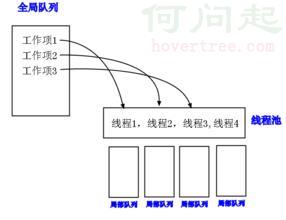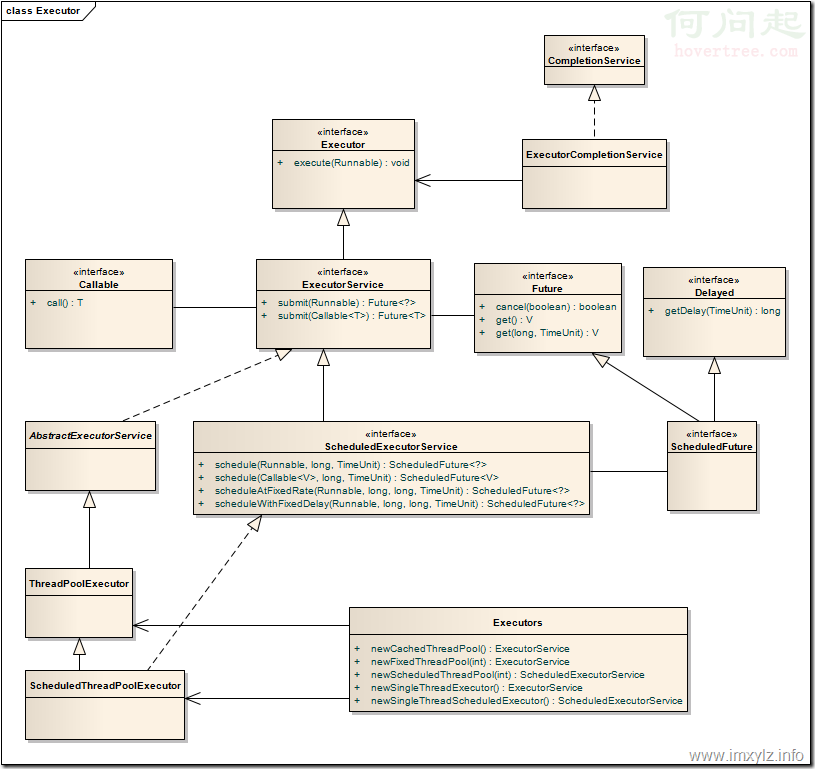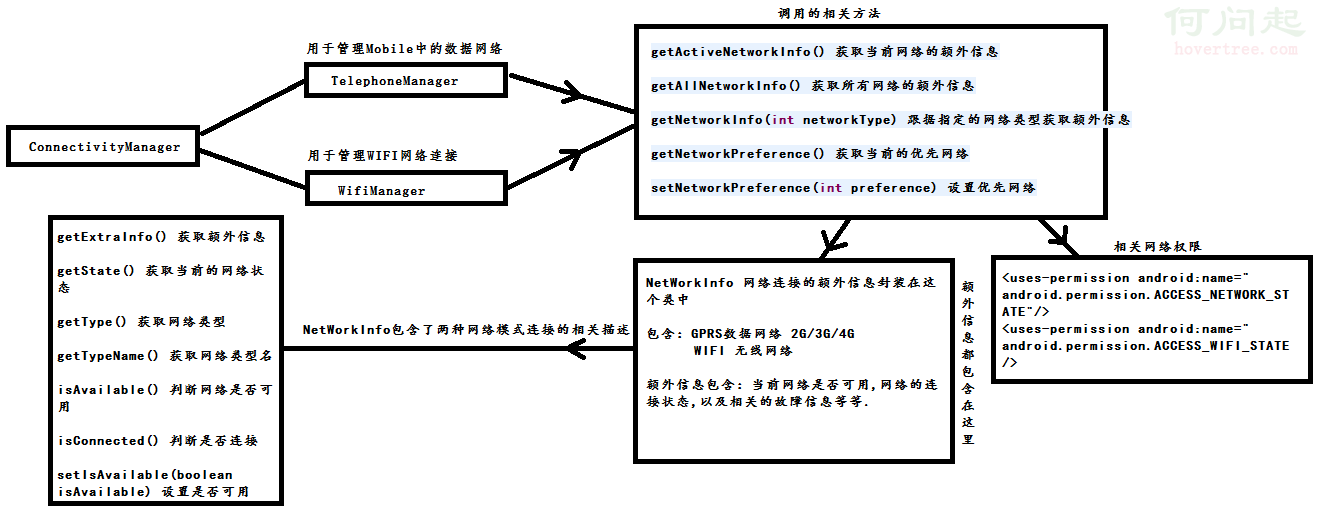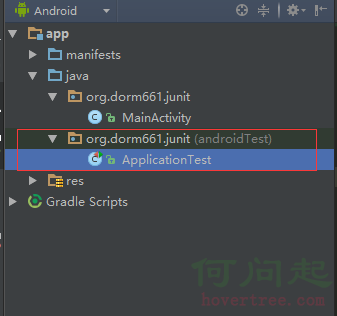編輯:Android編程入門
一,簡述線程池:
線程池是如何工作的:一系列任務出現後,根據自己的線程池安排任務進行。
如圖:

線程池的好處:
線程池的具體實現為ThreadPoolExeutor,其接口為Executor。
ThreadPoolExecutor提供了一系列的參數用於配置線程池。
public ThreadPoolExecutor(int corePoolSize,
int maximumPoolSize,
long keepAliveTime,
TimeUnit unit,
BlockingQueue<Runnable> workQueue,
ThreadFactory threadFactory) {
this(corePoolSize, maximumPoolSize, keepAliveTime, unit, workQueue,
threadFactory, defaultHandler);
}
參數含義如下:
其執行任務時大致遵顼如下規則:
二,線程池的相關類結構解析
看一下線程池的類結構圖:

說以下這幾點:
這是一個抽象工廠模式!
Executor和Executors的區別:
Executor僅僅是一個接口,其只有一個方法,execute()方法(執行方法)。
public interface Executor {
void execute(Runnable command);
}
而Executors是一個沒有繼承任何類的方法,其作為一個工廠方法類,用於創建形形色色的線程池等對象。如:FixedThreadPool、defaultThreadFactory(下面會具體講),而這些具體的線程池方案(FixedThreadPool)亦或者自定義的線程池方案(ThreadPoolExeutor)都是來自ExecutorService接口,這個接口也是繼承於Executor接口。通過類結構圖可以很清楚的看到。
如,Executors生產出ExecutorService對象,源碼如下
public static ExecutorService newSingleThreadExecutor(ThreadFactory threadFactory) {
return new FinalizableDelegatedExecutorService
(new ThreadPoolExecutor(1, 1,
0L, TimeUnit.MILLISECONDS,
new LinkedBlockingQueue<Runnable>(),
threadFactory));
}
說到工廠模式,ThreadPoolExeutor的參數threadFactory是一個接口,僅有newThread方法,代碼如下
public interface ThreadFactory {
Thread newThread(Runnable r);
}
其作用和executor接口類似,體現面向接口編程思想。其中例如如下兩個方法,是工廠方法類Executors所生成的ThreadFactory對象。
public static ThreadFactory defaultThreadFactory() {
return new DefaultThreadFactory();
}
public static ThreadFactory privilegedThreadFactory() {
return new PrivilegedThreadFactory();
}
defaultThreadFactory是這樣創建線程的,如果要自定義不妨參照一下。
static class DefaultThreadFactory implements ThreadFactory {
private static final AtomicInteger poolNumber = new AtomicInteger(1);
private final ThreadGroup group;
private final AtomicInteger threadNumber = new AtomicInteger(1);
private final String namePrefix;
DefaultThreadFactory() {
SecurityManager s = System.getSecurityManager();
group = (s != null) ? s.getThreadGroup() :
Thread.currentThread().getThreadGroup();
namePrefix = "pool-" +
poolNumber.getAndIncrement() +
"-thread-";
}
public Thread newThread(Runnable r) {
Thread t = new Thread(group, r,
namePrefix + threadNumber.getAndIncrement(),
0);
if (t.isDaemon())
t.setDaemon(false);
if (t.getPriority() != Thread.NORM_PRIORITY)
t.setPriority(Thread.NORM_PRIORITY);
return t;
}
}
三 具體線程池的使用
說了那麼多,要具體看看系統提供的線程池,主要是這四個:
例子:這裡設置了4個runnable和2個核心線程。
Runnable runnable = new Runnable() {
@Override
public void run() {
Log.d("hello","sleep前");
SystemClock.sleep(3000);
Log.d("hello", "sleep後");
}
};
......
ExecutorService executorService = Executors.newFixedThreadPool(2);
executorService.execute(runnable);
executorService.execute(runable1);
executorService.execute(runable2);
executorService.execute(runable3);
輸出如下,
06-24 15:49:47.962 12462-12497/? D/hello: sleep1前 06-24 15:49:47.962 12462-12496/? D/hello: sleep前 06-24 15:49:50.962 12462-12497/com.example.hang.myapplication D/hello: sleep1後 06-24 15:49:50.962 12462-12497/com.example.hang.myapplication D/hello: sleep2前 06-24 15:49:50.972 12462-12496/com.example.hang.myapplication D/hello: sleep後 06-24 15:49:50.972 12462-12496/com.example.hang.myapplication D/hello: sleep3前 06-24 15:49:53.962 12462-12497/com.example.hang.myapplication D/hello: sleep2後 06-24 15:49:53.972 12462-12496/com.example.hang.myapplication D/hello: sleep3後
可以看到,每次僅有兩個線程去執行,當其中一個執行完畢後才輪到下一個。
當 核心線程數量改為 4 時,則會一次性執行完這4個runnable。
例子,修改為將上述的 ExecutorService executorService = Executors.newFixedThreadPool(2);替換為
ExecutorService executorService = Executors.newCachedThreadPool();,輸出如下,一次性執行4個線程,且線程順序不定。
06-24 15:53:08.582 16801-16873/com.example.hang.myapplication D/hello: sleep2前 06-24 15:53:08.582 16801-16872/com.example.hang.myapplication D/hello: sleep1前 06-24 15:53:08.582 16801-16871/com.example.hang.myapplication D/hello: sleep前 06-24 15:53:08.582 16801-16875/com.example.hang.myapplication D/hello: sleep3前 06-24 15:53:11.582 16801-16873/com.example.hang.myapplication D/hello: sleep2後 06-24 15:53:11.582 16801-16872/com.example.hang.myapplication D/hello: sleep1後 06-24 15:53:11.582 16801-16871/com.example.hang.myapplication D/hello: sleep後 06-24 15:53:11.582 16801-16875/com.example.hang.myapplication D/hello: sleep3後
例子:這裡是延遲2000ms後開始執行
ScheduledExecutorService scheduledExecutorService = Executors.newScheduledThreadPool(3);
scheduledExecutorService.schedule(runnable,2000, TimeUnit.MILLISECONDS);
scheduledExecutorService.schedule(runable1, 2000, TimeUnit.MILLISECONDS);
scheduledExecutorService.schedule(runable2, 2000, TimeUnit.MILLISECONDS);
scheduledExecutorService.schedule(runable3, 2000, TimeUnit.MILLISECONDS);
例子:延遲10ms後開始每1000ms執行一次runnable。
scheduledExecutorService.scheduleAtFixedRate(runnable,10,1000,TimeUnit.MILLISECONDS);
這裡就不做例子了,就是4個排著隊依次執行,且不會亂序。
06-24 16:05:02.782 32057-32125/com.example.hang.myapplication D/hello: sleep前 06-24 16:05:05.782 32057-32125/com.example.hang.myapplication D/hello: sleep後 06-24 16:05:05.782 32057-32125/com.example.hang.myapplication D/hello: sleep1前 06-24 16:05:08.782 32057-32125/com.example.hang.myapplication D/hello: sleep1後 06-24 16:05:08.782 32057-32125/com.example.hang.myapplication D/hello: sleep2前 06-24 16:05:11.782 32057-32125/com.example.hang.myapplication D/hello: sleep2後 06-24 16:05:11.782 32057-32125/com.example.hang.myapplication D/hello: sleep3前 06-24 16:05:14.782 32057-32125/com.example.hang.myapplication D/hello: sleep3後
 ListView實現加載不同Item布局
ListView實現加載不同Item布局
大家好,今天總結一片ListView加載不同Item布局的博客,在Android的app開發當中ListView貌似是基本配置,一般我們的ListView主要是作為列表類
 java/android線程池詳解
java/android線程池詳解
一,簡述線程池:線程池是如何工作的:一系列任務出現後,根據自己的線程池安排任務進行。如圖: 線程池的好處:重用線程池中的線程,避免因為線程的創建和銷毀所帶來的性能開銷。能
 Android學習筆記之ConnectivityManager+NetWorkInfo
Android學習筆記之ConnectivityManager+NetWorkInfo
PS:眼看就要開學了,該收收心了. 學習內容:1.ConnecivityManager2.NetWorkInfo Connectivit
 Android Studio 單元測試
Android Studio 單元測試
單元測試(unit testing),是指對軟件中的最小可測試單元進行檢查和驗證。 針對Android開發,目前網上有很多在Eclipse環境下進行單元測試的教程,然而